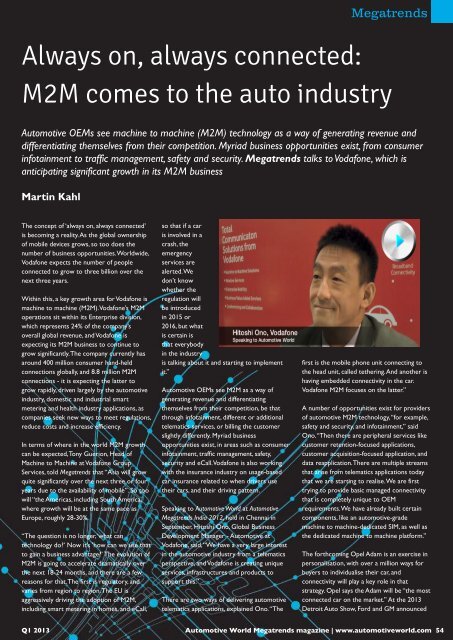megatrends
megatrends
megatrends
Create successful ePaper yourself
Turn your PDF publications into a flip-book with our unique Google optimized e-Paper software.
Always on, always connected:<br />
Megatrends<br />
M2M comes to the auto industry<br />
Automotive OEMs see machine to machine (M2M) technology as a way of generating revenue and<br />
differentiating themselves from their competition. Myriad business opportunities exist, from consumer<br />
infotainment to traffic management, safety and security. Megatrends talks to Vodafone, which is<br />
anticipating significant growth in its M2M business<br />
Martin Kahl<br />
The concept of ‘always on, always connected’<br />
is becoming a reality. As the global ownership<br />
of mobile devices grows, so too does the<br />
number of business opportunities. Worldwide,<br />
Vodafone expects the number of people<br />
connected to grow to three billion over the<br />
next three years.<br />
Within this, a key growth area for Vodafone is<br />
machine to machine (M2M). Vodafone’s M2M<br />
operations sit within its Enterprise division,<br />
which represents 24% of the company’s<br />
overall global revenue, and Vodafone is<br />
expecting its M2M business to continue to<br />
grow significantly. The company currently has<br />
around 400 million consumer hand-held<br />
connections globally, and 8.8 million M2M<br />
connections - it is expecting the latter to<br />
grow rapidly, driven largely by the automotive<br />
industry, domestic and industrial smart<br />
metering and health industry applications, as<br />
companies seek new ways to meet regulations,<br />
reduce costs and increase efficiency.<br />
In terms of where in the world M2M growth<br />
can be expected, Tony Guerion, Head of<br />
Machine to Machine at Vodafone Group<br />
Services, told Megatrends that “Asia will grow<br />
quite significantly over the next three or four<br />
years due to the availability of mobile”. So too<br />
will “the Americas, including South America,<br />
where growth will be at the same pace as<br />
Europe, roughly 28-30%.<br />
“The question is no longer, ‘what can<br />
technology do?’ Now it’s 'how can we use that<br />
to gain a business advantage?’ The evolution of<br />
M2M is going to accelerate dramatically over<br />
the next 18-24 months, and there are a few<br />
reasons for that. The first is regulatory, and<br />
varies from region to region. The EU is<br />
aggressively driving the adoption of M2M,<br />
including smart metering in homes, and eCall,<br />
Q1 2013<br />
so that if a car<br />
is involved in a<br />
crash, the<br />
emergency<br />
services are<br />
alerted. We<br />
don’t know<br />
whether the<br />
regulation will<br />
be introduced<br />
in 2015 or<br />
2016, but what<br />
is certain is<br />
that everybody<br />
in the industry<br />
is talking about it and starting to implement<br />
it.”<br />
Automotive OEMs see M2M as a way of<br />
generating revenue and differentiating<br />
themselves from their competition, be that<br />
through infotainment, different or additional<br />
telematics services, or billing the customer<br />
slightly differently. Myriad business<br />
opportunities exist, in areas such as consumer<br />
infotainment, traffic management, safety,<br />
security and eCall. Vodafone is also working<br />
with the insurance industry on usage-based<br />
car insurance related to when drivers use<br />
their cars, and their driving pattern.<br />
Speaking to Automotive World at Automotive<br />
Megatrends India 2012, held in Chennai in<br />
September, Hitoshi Ono, Global Business<br />
Development Manager - Automotive at<br />
Vodafone, said, “We have a very large interest<br />
in the automotive industry from a telematics<br />
perspective, and Vodafone is creating unique<br />
services, infrastructures and products to<br />
support this.”<br />
There are two ways of delivering automotive<br />
telematics applications, explained Ono. “The<br />
first is the mobile phone unit connecting to<br />
the head unit, called tethering. And another is<br />
having embedded connectivity in the car.<br />
Vodafone M2M focuses on the latter.”<br />
A number of opportunities exist for providers<br />
of automotive M2M technology, “for example,<br />
safety and security, and infotainment,” said<br />
Ono. “Then there are peripheral services like<br />
customer retention-focused applications,<br />
customer acquisition-focused application, and<br />
data reapplication. There are multiple streams<br />
that arise from telematics applications today<br />
that we are starting to realise. We are first<br />
trying to provide basic managed connectivity<br />
that is completely unique to OEM<br />
requirements. We have already built certain<br />
components, like an automotive-grade<br />
machine to machine-dedicated SIM, as well as<br />
the dedicated machine to machine platform.”<br />
The forthcoming Opel Adam is an exercise in<br />
personalisation, with over a million ways for<br />
buyers to individualise their car, and<br />
connectivity will play a key role in that<br />
strategy. Opel says the Adam will be “the most<br />
connected car on the market.” At the 2013<br />
Detroit Auto Show, Ford and GM announced<br />
Automotive World Megatrends magazine | www.automotiveworld.com<br />
54


